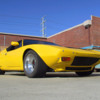In motorsport certain aspects of the chassis set up are varied from track to track, there is no one set-up good for every track. Teams can spend a day or a month preparing the chassis for race day. A chassis can be set up for the preferences of a driver too.
The same is true for high performance street cars. A street car can't be set up for every particular road, but it can be set up for the general use of the vehicle and the driving "style" of the owner. There's no one chassis set-up good for every person, we use our cars in differing applications and we all drive at differing levels of speed and aggression.
While compliance in the suspension is good, the car should only bottom out on the pavement, or against the suspension bumpers, every once in a while, on the fastest - biggest bumps. Bottoming out is very stressful for both the driver and the chassis. Obviously, the lower a car is, the faster it is driven, the more aggressive it is driven, the stiffer the suspension must be to prevent frequent bottoming and to give the chassis poise when driven that way.
Race car or sports car suspensions are limited in how soft the springs can be and how stiff the anti-sway bars can be for two reasons (1) the stiffer the anti-sway bars are, the less independent the suspension is, and (2) it is quite possible to make the anti-sway bars so stiff they lift the inside front tire in the corners, which reduces cornering traction; needless to say, that's too stiff. The 1" anti-sway bars available for the Pantera do this. If springs that are too soft are coupled with anti-sway bars that are too stiff the car would have suspension that is very compliant over bumps that effect both tires (gutters) but too stiff over bumps that effect only one tire (pot holes). The goal is to give the suspension balance betwen springs and anti-sway bars so it has the same amount of compliance over both types of road irregularities. This is not easy to achieve.
My point is not that soft springs & stiff anti-sway bars is the wrong approach, I've already stated there is a need for suspension compliance; my point is that there are limits in how far you can take this approach.
Certain choices in chassis components can add harshness to a chassis without accomplishing anything beneficial for the vehicles handling. The shock absorbers are perhaps the worst offenders in this aspect. Shock absorbers should dampen motion without introducing harshness into the ride, harshness is the opposite of compliance, and the whole subject of soft springs is really about compliance. You know a chassis is dialed in when you observe a vehicle traveling across a bumpy section of road, the tires are going up and down madly, but the vehicle and driver appear to be traveling smoothly, isolated from the bumps in the road.
quote:
Originally posted by DOES 200:
Not sure, but maybe it depends on how fast you plan on driving regarding spring stiffness. My red car with the aluminum shocks seems just right at high speed, but a little stiff when just tooling around the hood. It is not bad at low speed, but I do notice the stiffness is a little greater at lower speed.
Jan ... Koni shocks dampen well around town and at high speed. Its progressive dampening. The faster they compress (higher speeds) the more they dampen.
-G







